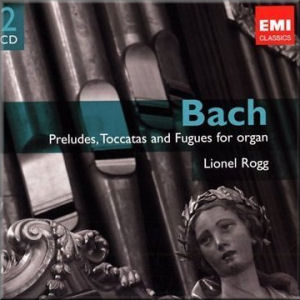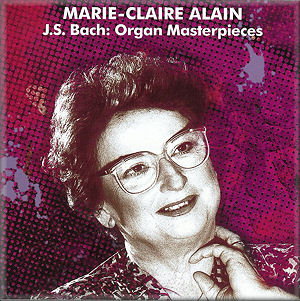 |
 |
|


alternatively
CD: AmazonUK
AmazonUS
|
Johann Sebastian BACH (1685-1750)
Preludes, Toccatas and Fugues for Organ
CD 1
Toccata and Fugue in d minor, BWV565 [8:20]
Toccata Adagio and Fugue in C, BWV564 [14:54]
Toccata and Fugue in d minor, BWV538, ‘Dorian’ [12:47]
Toccata and Fugue in F, BWV540 [14:24]
Prelude and Fugue in C, BWV547 [10:21]
Prelude and Fugue in b minor, BWV544 [13:00]
CD 2
Fantasia and Fugue in g minor, BWV542* [11:38]
Prelude and Fugue in G, BWV541* [7:29]
Prelude and Fugue in a minor, BWV543 [9:27]
Prelude and Fugue in c minor, BWV546 [12:16]
Prelude and Fugue in A minor, BWV548 [14:09]
Prelude and Fugue in f minor, BWV534 [9:28]
Passacaglia and Fugue in c minor, BWV582 [13:36]
 Lionel Rogg (organ)
Lionel Rogg (organ)
rec. November/December, 1975 on the Metzler organ, Cathedral of
St Peter, Geneva; February, 1976 on the Marcussen-Andersen organ,
Monastery of Sorø, Denmark*. ADD.
 EMI CLASSICS GEMINI 2642892 [73:49 + 78:04]
EMI CLASSICS GEMINI 2642892 [73:49 + 78:04] 
|


CD: AmazonUK |
Johann Sebastian BACH (1685-1750)
Organ Masterpieces
CD 1
Toccata and Fugue in d, BWV 565 [8:05]
Toccata, Adagio and Fugue in C, BWV 564 [14:04]
4 Chorale Preludes, BWV 608, 610, 615, 639 (Orgelbüchlein) [9:53]
Concerto in a minor, after Vivaldi, BWV 593 [11:31]
Toccata and Fugue in d, BWV 538 ‘Dorian’ [12:53]
Toccata and Fugue in C, BWV 566 [11:02]
Chorale Prelude, Nun komm, der Heiden Heiland, BWV 659 (Achtzehn Choräle von
verschiedener Art) [4:52]
CD 2
Prelude and Fugue in D, BWV 532 [10:34]
Chorale Prelude Jesus bleibet meine Freude (Cantata, BWV 147) [3:47]
Sonata No.3 in d, BWV 527 [12:47]
Prelude and Fugue in C, BWV 547 [11:12]
6 Chorale Preludes, BWV 645–650 (Schübler Choräle) [17:52]
5 Chorale Preludes, BWV 727, 729–731, 734 [10:25]
 Marie-Claire
Alain (organ) Marie-Claire
Alain (organ)
rec. 1983-1985. DDD.
 WARNER CLASSICS
MAESTRO 2564 68975-5 [73:31 + 67:33] WARNER CLASSICS
MAESTRO 2564 68975-5 [73:31 + 67:33]  |
|
|
For many potential buyers one or both of these well-filled
and reasonably priced 2-CD sets will be just what they were
looking for. The Lionel Rogg recordings are taken from a 5-LP
box issued in 1976. Four organs were employed for that album,
of which two are represented here for what is described as ‘Volume
1’.
Even before he made these recordings for EMI, Lionel Rogg’s
Bach performances on the Bach Recordings and Harmonia Mundi
labels had received critical praise. His 1969 version of the Art of Fugue, now available on another EMI Gemini reissue
with the Organ Concertos (3817662) had also been widely
welcomed. He had also recorded for Bach Recordings two of the
works on the new reissue, BWV541 and 547, on that strange hybrid
instrument, the pedal-harpsichord.
The Marie-Claire Alain recordings are excerpted from her Warner
Classics’ 14-CD set of Bach from the late 1980s and early 1990s,
made on a series of historic organs. There’s also a 55-minute
DVD which she made at about the same time, demonstrating some
of the organs employed for that series; Kirk McElhearn described
it as ‘full of insights that any fan of organ music will appreciate’
– see review.
Epithets such as ‘stupendously good’ were applied by reviewers
to Rogg’s recordings of the 1960s and 1970s. Similarly, Alain’s
Bach has always been highly regarded, so, on the face of it,
it should be possible to recommend both sets, principally to
those beginning to explore Bach’s organ music and to connoisseurs
alike.
Four works are common to both recordings. Both open CD1 with
the ubiquitous Toccata and Fugue in d minor, BWV565,
now widely regarded as not the work of JS Bach, though it is
difficult to imagine that there existed a contemporary composer,
now unknown, capable of having produced it. Both performances
are good, with Alain slightly faster than Rogg. I slightly prefer
the sound of the organ of St Bavokerk, Haarlem, on which her
recording was made, but there is very little in it. Warner track
the Toccata and Fugue separately, but I can hardly imagine anyone
wishing to play either track on its own, unless for teaching
purposes.
The same is true of the following Toccata, Adagio and Fugue
in C, BWV564; three tracks here, again, on Warner to the
one on EMI, with Alain once more slightly faster than Rogg.
As with BWV565, I could happily live with either performance.
Again, a slight preference for the organ, this time that of
the Jakobijnkerk at Leeuwarden, inclines me marginally to prefer
Alain.
The third work common to both recordings is the so-called ‘Dorian’
Toccata and Fugue in d minor, BWV538. This time the
tempi are almost exactly identical – Alain is six seconds slower –
and, once again, there’s very little in it. This time Alain
plays the work on the Silbermann organ in Freiburg Cathedral
and I very much like its bright sound, though it’s capable
of packing quite a punch when necessary.
In the fourth work common to both programmes, the Prelude
and Fugue in C, BWV547, Alain is slower than Rogg. Once
again, however, both performances are convincing within their
own terms. As a reminder that there are other considerations
than tempo, my benchmark performances by Helmut Walcha are
mostly
slower than either Alain or Rogg, yet never lacking in conviction.
Walcha’s 2-CD set containing BWV547, 564 and the inevitable
565, together with the Art of Fugue (DG Archiv 477 6508)
has recently been deleted, though some dealers still seemed
to have copies when last I checked. For details, see my July,
2009, Download
Roundup.
With so little to choose between these two recordings, the
rest of the programmes could well be a deciding factor. Here,
too,
I thought that Warner had the slight advantage in terms of
the greater variety of music and of the organs employed – in addition
to those already named, we have those of St Laurenskerk, Alkmaar
(partly Schnittker), Église Saint-Martin, Masevaux, Aa Kerk
and Martinikerk (both Schnittker), Groningen, Stiftskirche Grauhof,
Goslar and another Silbermann organ, that of St Georgenkirche,
Rötha.
Both recordings are good, with the Warner (DDD) having a slight
edge over the older ADD EMI sound.
The notes in the EMI booklet are minimalist in the extreme,
though they include an admission that the famous BWV565 may
not be by Bach at all. The Warner booklet offers slightly fuller
documentation; though still rather brief, it includes a rather
more detailed discussion of the authenticity of BWV565. I suppose
it’s too much to ask for specifications of the organ in this
price-bracket, though Naxos usually manage to include one; I’d
very much have welcomed such information. To have been able
to compare the two organists’ chosen registrations for individual
works would have been even more fascinating.
I should briefly mention another inexpensive selection of Bach’s
organ music, this time on three budget-price CDs and featuring
Werner Jacob (EMI Triples 5093932); I made this Bargain of the
Month in June, 2008 – see review.
That set includes the Trio Sonata No.3 and the Concerto in
a
after Vivaldi, the former taken considerably more slowly than
Alain and the Concerto at much the same pace. Comparing the
two, I now think that I prefer Alain in the Sonata, while honours
are about even in the Concerto. I also marginally prefer Alain’s
slightly faster account of Nun komm, BWV659, and of the
Schübler Chorales.
I described Jacob’s performance of the Toccata and Fugue
in d, BWV565, as ideal – grandeur without pomposity. At
their different tempi, Rogg and Alain, though both are faster
than Jacob, achieve just about the same balance.
Jacob also includes a livelier version than Rogg of BWV544,
a slightly slower version than Rogg of BWV582 and a version
of the ‘Dorian’ Toccata and Fugue at about the same tempo as
Rogg and Alain. The EMI booklet for the Jacob set is as minimal
as that for Rogg.
Beginners would probably be best advised to go for the Warner/Alain
recording for its marginally fleeter performances and greater
variety of repertoire and of organs employed. I made Werner
Jacob’s EMI Triples set Recording of the Month and, as I’m inclined
to prefer Marie-Claire Alain’s performances to his where the
two sets overlap, I can’t withhold the same accolade from her.
As the prices of the Alain and Rogg sets are so reasonable,
however, and both have so much to offer, you might consider
buying both and even adding the Jacob set. There would be no
better way to demonstrate that slightly different interpretations
of Bach’s organ music can be equally valid.
Brian Wilson
|
|

